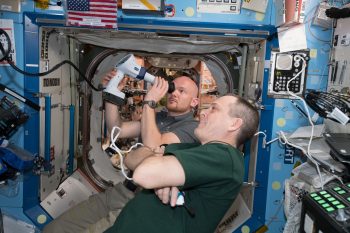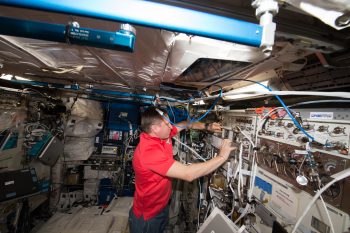It is not just astronauts who perform differently in space. Alongside experiments looking at time perception, resting muscle tone and hand-eye coordination, ESA astronaut Alexander Gerst is also working with researchers to better understand foam, metal, alloys and granular matter in the greatest lab off Earth.

ESA astronaut Alexander Gerst and NASA astronaut Ricky Arnold test their ocular health with a fundoscope. Credit: ESA/NASA
Recently Alexander worked to replace a video management unit for the Fluid Science Laboratory housed within the European Columbus module on board the International Space Station, and carried out commissioning activities for the Soft Matter Dynamics instrument. The first experiment carried out using this new instrument was the Compacted Granulars experiment. Alexander also supported investigation into complex plasmas, and conducted a fundoscopy to test his eye health.
Now the time has come for us to test our eyes and take a closer look. Welcome to the latest snapshot of European activity aboard the International Space Station.
Fluids and foams
The Fluid Science Laboratory, stationed in the Columbus module, enables researchers to study how different fluids and materials behave in the absence of gravity. However, as the Columbus module is now over ten years old, some parts are now due for an upgrade.
With a bit of help from NASA astronaut Ricky Arnold, Alexander recently replaced a video management unit that sits within the Fluid Science Laboratory and records the experiments for analysis back on Earth. The new unit is designed to make this analysis even more precise, and tests show it is already working as planned.
Because the Fluid Science Laboratory is a multi-user facility, it can accommodate a number of different experiments at once. Each experiment is kept in its own experiment container and the equipment within these containers can be operated remotely, so minimal crew time is required.
Scientists carrying out this research are able to look at granular materials without the rapid sedimentation that occurs on Earth, foams without the drying effects of gravity, and emulsions (blends of liquid) unaffected by weight differences and separation.
The information they gain will help with Earth-based applications such as developing more effective drainage systems, as well as the future of transporting particles in space and even methods for asteroid mining.
The possibilities of plasma
Plasmas are found throughout the universe – from the interstellar medium, to the heat shields of spacecraft re-entering Earth’s atmosphere. Gaining a better understanding of how plasma crystals form in microgravity could lead to new research methods or improved spacecraft designs. But it could also pave the way for medical innovation, from food hygiene and treating skin diseases to water purification and odour management.
Plasma Kristall-4 (known as PK-4 to the crew) is the continuation of a series of collaborative studies between the European Space Agency and Russian Federal Space Agency, Roscosmos, investigating the behaviour of plasmas in space.

Russian cosmonaut Sergey Prokopyev installing a new experiment kit for PK-4 in the Columbus module. Credit: ESA/NASA-A.Gerst
In July, Russian cosmonaut Sergey Prokopyev installed a new experiment kit for PK-4 in the Columbus module. This was given the all-clear by the ground team and the first experiment runs are underway.
Space Station communication
New month, new communication tool. Another new piece of kit has been deployed aboard Columbus – this time to help astronauts carry out Space Station tasks and collaborate in real-time with on-the-ground experts.
Known as the mobile procedure viewer short duration mission experiment – or mobiPV SDM for short – it enables astronauts to view procedures on a smartphone mounted to their wrist. They can also exchange video (via a head-mounted camera), audio and text information with ground teams while retaining full use of their hands.




Discussion: one comment
Hallo, der Blog funktioniert leider nicht.
Bitte beheben!
Anja